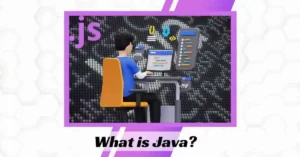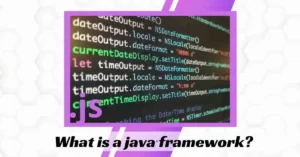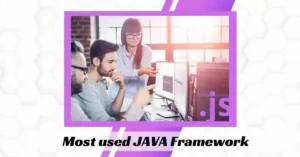Table of Contents
ToggleIntroduction
Java is a tricky language, and when combined with a framework, Java framework can provide the best solutions for any domain, be it e-commerce, banking, cloud computing, finance, big data, the stock market, IT, and more.
Frameworks give a structure to your applications. If we have a framework for testing, we can automate many things and get accurate results. There are frameworks for ORM, web applications, logging, data management, etc. In that case, it will simplify a developer’s life and help them concentrate on business logic.
What is Java?

Java is a cross-platform, object-oriented programming language that Sun Microsystems released in 1995. Today, Java is needed to run various applications such as games, social media applications, audio and video applications, etc.
It is an object-oriented language similar to C++ but with advanced and simplified features. This language is free to access and can run on all platforms.
Give a visit to the best data science course in delhi
What is a java framework?

A Java framework is particular to the Java programming language. Java frameworks may include designful classes and functions that process, input, and manage hardware devices and interact with system software. It depends on the framework, the programmer’s skill level, what they’re trying to achieve, and their preferences.
Why are JAVA Frameworks needed?

Frameworks give a structure to your applications. If we have a framework for testing, we can automate many things and get accurate results. There are frameworks for ORM, web applications, logging, data management, etc. In that case, it will simplify a developer’s life and help them concentrate on business logic.
Most used JAVA Framework

Although many frameworks are built on Java, here are some very commonly used frameworks of different types- network applications, logging, ORM, etc. Note that each has benefits and can work best for various business use cases. We cannot say which is better because they are all good in different scenarios.
Also, have a look at the best data science course pune
Spring java framework
The core features of the Spring Java Framework can be used in developing Java applications. It is defined as a complete modular framework. It can be used for all-layer implementations of a real-time application, but we can establish all layers with Spring.
Spring Framework is a robust, lightweight application development framework for Enterprise Java.
Uses:
- Web application development
- Its attributes can be used to create any Java application
Advantages
- It adds a lightweight container that can be triggered without a web server or application server software.
- Spring supports JDBC, upgrades productivity, and decreases the error
- It targets to make J2EE development simple to use
- Spring supports both XML and annotation-based configuration
Companies who use Spring Java Framework
- Amazon
- Ebay
- Netflix using Spring boot
Hibernate
Hibernate ORM is a solid object-relational mapping JAVA Framework. It enables better communication through the Java programming language and relational database management systems.
When you work with Java, you’ll meet a problem called Object-Relational Impedance Mismatch. This is because OO languages and RDBMSs handle the data differently, leading to mismatch problems. So, this Hibernate allows you a framework that overcomes the mismatch problems of Java.
Suggested Blogs:-
- What Package in Java & Sub Packages, Learn Java
- Structure of Java Program & Explained In Full Depth
Uses
- It allows you to develop persistent classes following the object-oriented idiom.
- It is an advanced ORM framework that lets you perform the database operation on Java entities.
Advantages
- Portability, productivity, maintainability
- The free and open-source framework
- It removes a lot of repetitive code from the JDBC API
Companies that use Hibernate Java Framework
- IBM
- DELL
- ORACLE
Struts
Struts is a full-featured Java framework justified, and the Apache Software Foundation invented this. It’s a solid platform with a large community, often compared to the Spring Framework. Struts allow you to create enterprise-level Java applications that are easy to maintain over time.
It ensures the MVC software design pattern and has a plugin-based architecture. Plugins make an opportunity to extend the framework to fit different project needs. Struts plugins are basic Jar Packagers, so they are portable, and you can also add them to your app’s classpath. Some plugins are bundled with the framework, while you can add others from third-party sources.
Uses
- The Struts 2 framework is used to develop an MVC-based web application.
- It uses and extends the Java Servlet API to help developers to adopt MVC architecture.
Advantages
- This framework documentation is written for active web developers and assumes a working knowledge of how Java web applications are built.
- Reduces the development time and makes the manageability of the application easier
- It offers Centralized Configuration, i.e., rather than coding information into Java programs, and many Struts values are r
epresented in XML or property files. - You can combine Struts with other Java frameworks to perform tasks not built on the platform.
Companies who use Struts Java Framework
- ACCENTURE
- INFOSYS
- Nextgen Technologies
Blade
The Blade is a lightweight, high-performance Java framework that allows you to build fast web applications effectively. The creator’s goal is for users to understand the whole framework in a single day. To attain this, Blade focuses on clarity and choice.
The Blade framework follows the MVC software design pattern. It has an easy-to-understand design, not depending on any third-party libraries or introducing too many layers. The Blade is based on Java 8, and the Netty web server and template engine are built into the framework. Its footprint is minimal; the source code is less than 500 kb.
Uses
- It helps you to be self-contained, productive, elegant, intuitive, and super fast
- Used to create a small MVC application
Advantages
- Blade supports plugin extensions and web jar resources
- Support for configuring multiple files
- It also possesses CSRF and XSS defense support
Companies that use the blade java framework
- Smart admin
- Stormcatch API’s
- Spookies
Play
The Play Framework makes it possible to build lightweight Java and Scala applications for desktop and mobile. Most Java frameworks it doesn’t depend on Jakarta EE standards. Play is often in contrast to web frameworks of scripting languages, such as Ruby on Rails for Ruby or Django for Python. It aims to eliminate the inconveniences of traditional Java web development, such as slow development cycles and too much configuration.
Uses
- Web applications that demand content creation
- Builds Java and Scala applications
Advantages
- Offers features like hot code reloading, convention over configuration, and error messages in the browser
- It supports non-blocking I/O, which is crucial for high-performance applications.
- More flexible and failure-tolerant results
Companies that use Play JAVA Framework
- Zalando
- Coursera
Vert.x
Vert.x is a polyglot framework running on the Java Virtual Machine. It allows you to write apps in programming languages such as Java, JavaScript, Groovy, Ruby, Scala, and Kotlin. Its event-driven architecture results in applications that scale nicely even with minimal hardware resources.
Vert.x is developed and maintained by the Eclipse Foundation. The ‘x’ in Vert.x refers to its polyglottic nature, meaning you can write valid code in several languages. It provides idiomatic APIs for every supported programming language.
Advantages
- loads fast
- modular architecture
- extensible
- unopinionated (you can structure your application as you want)
- easy-to-use app generator
Companies that use Vert.x JAVA Framework
- Yahoo! Inc
- Movemedical
Dropwizard
Dropwizard is a high-performance, straightforward Java framework for rapidly developing RESTful web services. It’s especially suitable for creating Java microservices.
The Dropwizard framework combines several well-established Java libraries to provide a fast, distraction-free development platform. It has an embedded Jetty server, Google Guava, Logback, Hibernate Validator, Joda Time, and many other popular Java libraries.
Uses
- Operations-friendly Java framework
- Helps in creating Java microservices
Advantages
- You can efficiently perform rapid prototyping
- It develops high-performance RESTful web services
- It also supports many open-source and independent libraries
- Quick Project Bootstrap
- Increase in productivity
Companies who use Dropwizard JAVA Framework
- CRED
- Wayfair
- Rent the Runway
Vaadin
Vaadin provides a platform for streamlined Java development. It allows you to build web applications from customizable components focusing on performance, user experience, and accessibility.
Vaadin Flow provides a high-level Java API to manage your app’s technical aspects, from automatic server-client communication to WebSockets to data binding. As Flow runs on the JVM, you can access the whole Java ecosystem; for instance, you can run your app with Spring Boot. Flow also lets you write your app in Kotlin or Scala.
Uses
- This framework automates all the communication between the browser and the server.
- It simplifies web application development.
Advantages
- Vaadin allows binding data using either MVC or MVP.
- Drag and drop support, along with other outstanding features, simplifies the creation of single-page UIs for Java applications
- Automatic server-client communication with WebSocket support
- Use Java or HTML to build views.
Companies that use Vaadin JAVA Framework
- Bank of America
- PUMA
- Motorola
Conclusion
Java can provide the best solutions for any domain: e-commerce, banking, cloud computing, finance, big data, the stock market, IT, and more. Frameworks give a structure to your applications. If we have a framework for testing, we can automate many things and get accurate results.
That’s a wrap on our Java framework. As each JAVA framework serves different purposes, understanding their uses and advantages is essential before choosing one or more for your Java project.
Frequently Asked Questions
What is the most common Java framework?
Spring JAVA Framework
The core features of the Spring Java Framework can be used in developing Java applications. It is defined as a complete modular framework. It can be used for all-layer implementations of a real-time application, but we can establish all layers with Spring.
Spring Framework is a robust, lightweight application development framework for Enterprise Java.
What is the backend in Java?
Java backend frameworks reduce the effort required to assemble and create applications, especially for server-side programming. At a high level, frameworks help define the structure of applications. Frameworks also support incorporating popular build automation tools like Maven and Gradle in applications.
Is Eclipse a Java framework?
Eclipse is an Application Framework…
If you exclude the plug-ins that make Eclipse an IDE, including Java language support, debugging, and team development support, you’re left with a comprehensive general application framework that supports a rich user experience.













